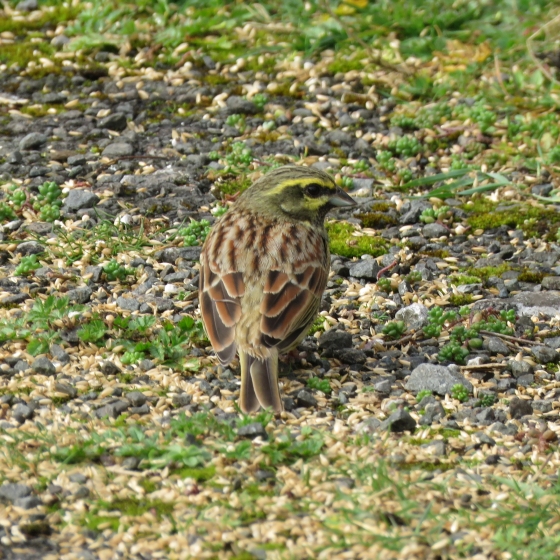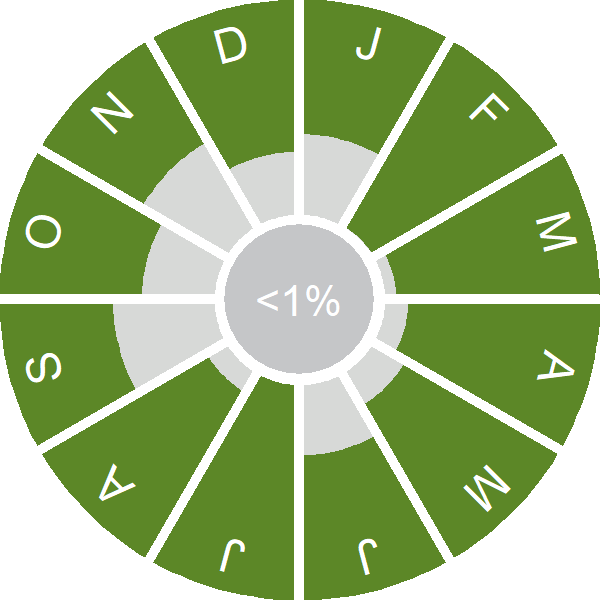Cirl Bunting
Emberiza cirlus (Linnaeus, 1766)
CL
 CIRBU
CIRBU  18580
18580

Family: Passeriformes > Emberizidae

This attractive species has a breeding and wintering range restricted to South-west England, namely southern Devon and Cornwall.
Its small range and population size means the Cirl Bunting has been on the UK Red List since 1996. Habitat improvements linked to targeted agri-environment scheme have seen numbers increase, and a re-introduction project has brought birds to Cornwall, extending the species range west from Devon.
The Cirl Bunting is a striking bird. Males have distinctive black and yellow facial stripes and chestnut brown on the wings. Females and juveniles are duller and look more similar to Yellowhammers.
Identification
Cirl Bunting identification is often straightforward.
SONGS AND CALLS
Listen to example recordings of the main vocalisations of Cirl Bunting, provided by xeno-canto contributors.
Call
Song
Develop your bird ID skills with our training courses
Our interactive online courses are a great way to develop your bird identification skills, whether you're new to the hobby or a competent birder looking to hone your abilities.
Browse training coursesStatus and Trends
Population size and trends and patterns of distribution based on BTO surveys and atlases with data collected by BTO volunteers.
CONSERVATION STATUS
This species can be found on the following statutory and conservation listings and schedules.
POPULATION CHANGE
Until the 1930s, the Cirl Bunting was a widespread breeding bird in Britain and found as far north as North Wales and Yorkshire (Evans 1992) It was still widespread but very localised across southern England at the time of the 1968–72 Breeding Atlas (Sharrock 1976), but further declines occurred during the 1970s (Sitters 1982) and by 1989 the species had become almost entirely restricted to a small area in Devon with a population of only around 118 territories (Evans 1992). Intensive conservation efforts have led to a partial recovery and, although still restricted to south-west England, the population has grown considerably. The last full survey in 2016 estimated a population of 1,079 breeding pairs (Jeffs et al. 2018).
DISTRIBUTION
Cirl Buntings were formerly widespread breeders across southern England and Wales, and a resident of the Channel Islands. Nowadays they are confined to a narrow coastal strip of south Devon and to east Cornwall where birds have been reintroduced.
Occupied 10-km squares in UK
| No. occupied in breeding season | 28 |
| % occupied in breeding season | 0.9 |
| No. occupied in winter | 23 |
| % occupied in winter | 0.8 |
European Distribution Map
DISTRIBUTION CHANGE
Until around 1930
Change in occupied 10-km squares in the UK
| % change in range in breeding season (1968–72 to 2008–11) | -84.5% |
| % change in range in winter (1981–84 to 2007–11) | --11.5% |
SEASONALITY
Cirl Bunting is a localised resident and recorded throughout the year.

Movement
Information about movement and migration based on online bird portals (e.g. BirdTrack), Ringing schemes and tracking studies.
RINGING RECOVERIES
View a summary of recoveries in the Online Ringing Report.
Biology
Lifecycle and body size information about Cirl Bunting, including statistics on nesting, eggs and lifespan based on BTO ringing and nest recording data.
PRODUCTIVITY & NESTING
CODES & CLASSIFICATION
Ring size 
|
A (pulli B) |
Field Codes 
|
2-letter: CL | 5-letter code: CIRBU | Euring: 18580 |
For information in another language (where available) click on a linked name
Research
Interpretation and scientific publications about Cirl Bunting from BTO scientists.
CAUSES AND SOLUTIONS
Causes of change
It has been suggested that loss of winter stubbles during the 1970s may have been a major cause of decline (Evans & Smith 1994). Lack of food in the breeding season as a result of agricultural intenstification, and a loss of nesting sites due to hedgerow management may also have contributed (Jeffs et al. 2016). Intensive research and conservation action has resulted in the provision (through agri-environment schemes) of breeding and wintering habitat designed specifically for the species which has driven the recent increases in Cirl Bunting numbers and also benefited other species (MacDonald et al. 2012, Jeffs et al. 2016). However, despite the population increases, there were no initial signs that Cirl Buntings might naturally recolonise sites outside the managed areas (Peach et al. 2001, Stanbury et al. 2010) and the limited availability of fallow and set-aside elsewhere may have prevented more substantial range expansion. The species was reintroduced to Cornwall between 2006 and 2011 (Jeffs et al. 2016) and the most recent survey also shows more encouraging signs of range expansion to north and east Devon although the species remains vulnerable without agri-environment schemes (Jeffs et al. 2018).
Links to more studies from ConservationEvidence.com
- The recent declines of farmland bird populations in Britain: an appraisal of causal factors and conservation actions
- Effects of removing duck-nest predators on nesting success of grassland songbirds
- Ecological factors affecting response of dark-eyed juncos to prescribed burning
Read more studies about Cirl Bunting on Conservation Evidence >
Would you like to search for another species?











Share this page